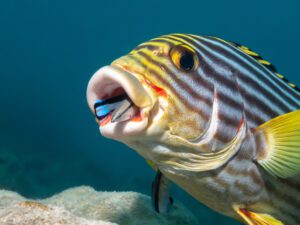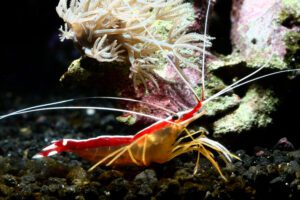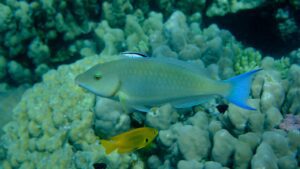Understanding the Role of Cleaner Fish in Bohol’s Marine Ecosystem
Bohol, located in the heart of the Philippines, is a premier diving destination famous for its rich biodiversity and vibrant coral reefs. Among the many fascinating marine creatures that inhabit these waters, cleaner fish play a crucial role in maintaining the health of the ecosystem. These small yet essential species provide an important service to larger fish and marine animals by keeping them free from parasites and dead skin.
In this blog, we’ll explore the role of cleaner fish in Bohol’s marine ecosystem, the different species that act as cleaners, and how their behavior contributes to the balance of underwater life. Whether you’re an avid diver or a marine enthusiast, understanding the significance of cleaner fish adds a deeper layer to the appreciation of Bohol’s incredible underwater world.
What Are Cleaner Fish?
Cleaner fish are species that engage in a mutualistic relationship with other fish and marine creatures and are always a favorite thing to spot while diving in Bohol. This means that both the cleaner fish and the animals they service benefit from the interaction. Cleaner fish feed on parasites, dead skin, and mucus from the bodies of larger fish and marine species, which provides them with a food source.
In return, the larger fish, known as the “clients,” receive a cleaning service that helps keep them healthy by removing harmful parasites, preventing infections, and even improving their overall well-being. This mutual relationship is essential in maintaining the balance of the reef ecosystem, as cleaner fish play a significant role in controlling parasite populations.
Cleaner Wrasse – The Most Famous Cleaners
 Species: Labroides dimidiatus
Species: Labroides dimidiatus
Location in Bohol: Coral reefs, cleaning stations
The cleaner wrasse is perhaps the most well-known and iconic of all cleaner fish species. These small, brightly colored fish are often found in cleaning stations, which are specific areas on the reef where larger fish come to receive their cleaning services. The cleaner wrasse typically has a distinctive blue or yellow color with black stripes running across their bodies, making them easy to spot as they move around larger fish.
Cleaner wrasse feed on parasites, dead skin, and mucus from the bodies of larger fish, such as groupers, snappers, and even sea turtles. They are highly skilled at removing parasites from hard-to-reach areas, such as gills and fins. This behavior is not only beneficial for the larger fish but also helps to maintain the overall health of the reef by preventing the spread of diseases caused by parasites.
 Cleaner Gobies – Small but Efficient Cleaners
Cleaner Gobies – Small but Efficient Cleaners
Species: Elacatinus spp.
Location in Bohol: Shallow reefs, crevices, and coral rubble
Cleaner gobies are another species that play an important role in Bohol’s marine ecosystem. These small fish are often found in crevices or hiding among coral rubble, where they set up their “cleaning stations.” Cleaner gobies typically work in pairs or small groups, waiting for larger fish to come by for a cleaning session.
While cleaner gobies are not as well-known as cleaner wrasses, they are highly efficient in their cleaning behavior. They feed on parasites and dead skin, particularly on the bodies of small fish, such as tangs, wrasses, and parrotfish. These tiny fish play an important role in the reef’s ecosystem by reducing the parasite load of many fish species and helping to maintain the health of the reef.
 Cleaner Shrimps – The Ultimate Underwater Janitors
Cleaner Shrimps – The Ultimate Underwater Janitors
Species: Lysmata amboinensis (Skunk Cleaner Shrimp), Periclimenes spp.
Location in Bohol: Coral reefs, cleaning stations
Cleaner shrimps, like their fish counterparts, are also known for their cleaning behavior. These vibrant red and white striped shrimps can be found in coral reefs, where they establish cleaning stations, waiting for larger fish and marine animals to approach them for cleaning. When a larger fish arrives, the cleaner shrimp scuttles over to remove parasites, dead skin, and any other debris from the fish’s body.
Cleaner shrimp have specialized claws that they use to gently pick off parasites and dead skin from the fish. These shrimp also provide an essential service to other marine creatures, such as moray eels, sea turtles, and even rays. Their cleaning behavior helps to prevent infections and reduce parasite burdens, ultimately promoting the health and survival of the animals they service.
 Cleaner Parrotfish – An Overlooked Yet Valuable Cleaner
Cleaner Parrotfish – An Overlooked Yet Valuable Cleaner
Species: Scarus spp.
Location in Bohol: Coral reefs and seagrass beds
Parrotfish are commonly known for their strong, beak-like mouths that they use to graze on algae and coral. However, many parrotfish also play an important role as cleaner fish, particularly in cleaning stations. While they may not engage in cleaning as frequently as cleaner wrasses or shrimp, parrotfish will occasionally clean other fish by nibbling away parasites and dead skin from their clients.
In Bohol’s coral reefs, parrotfish are frequently observed interacting with cleaner fish, often visiting cleaning stations where they can receive a service from cleaner wrasse, gobies, or shrimp. The presence of parrotfish in cleaning stations highlights the interconnectedness of reef species and their reliance on each other for survival.
The Role of Cleaner Fish in Bohol’s Reef Health
Cleaner fish are an essential part of the reef ecosystem in Bohol. By removing parasites and dead tissue from the bodies of larger fish, these species help prevent the spread of diseases and infections. This not only improves the health of the individual fish but also contributes to the overall biodiversity and stability of the reef ecosystem.
Moreover, the cleaning relationship between cleaner fish and their clients is a perfect example of mutualism, a biological interaction where both species benefit. While cleaner fish gain food, the larger fish maintain better health and are less vulnerable to parasites. This interdependence helps keep the marine ecosystem balanced and vibrant.
he Ecological Impact of Cleaner Fish
Cleaner fish play a pivotal role in regulating the populations of parasites within the marine ecosystem. By keeping fish populations healthy and free from harmful parasites, they help maintain the balance of the food web. Cleaner fish also indirectly contribute to the success of coral reefs by keeping fish populations healthy and reducing the likelihood of disease outbreaks that could harm reef life.
In addition, cleaner fish are crucial to supporting the economic value of the marine ecosystem in Bohol, as they contribute to the overall health of the reef, attracting tourists and divers to the area. Their role in maintaining the ecosystem’s health is vital for preserving the vibrant marine biodiversity that makes Bohol one of the top dive destinations in the world.
Conclusion
Cleaner fish are a fundamental part of Bohol’s marine ecosystem, providing an invaluable service to the reef’s diverse marine life. From the famous cleaner wrasse to the lesser-known cleaner gobies and shrimp, these species contribute to the health and sustainability of the reef. As you explore Bohol’s crystal-clear waters, take a moment to appreciate the role of cleaner fish and how their unique behavior supports the delicate balance of the ecosystem. Understanding their importance deepens our connection to the underwater world and highlights the need for conservation efforts to protect these remarkable species and their habitats.




